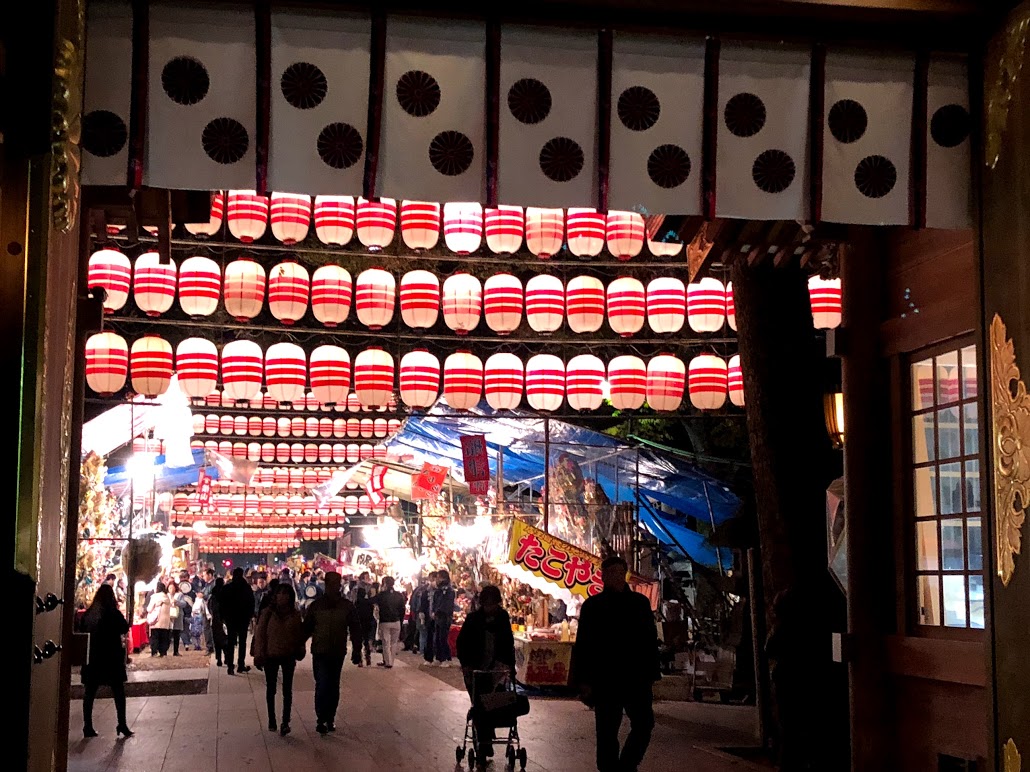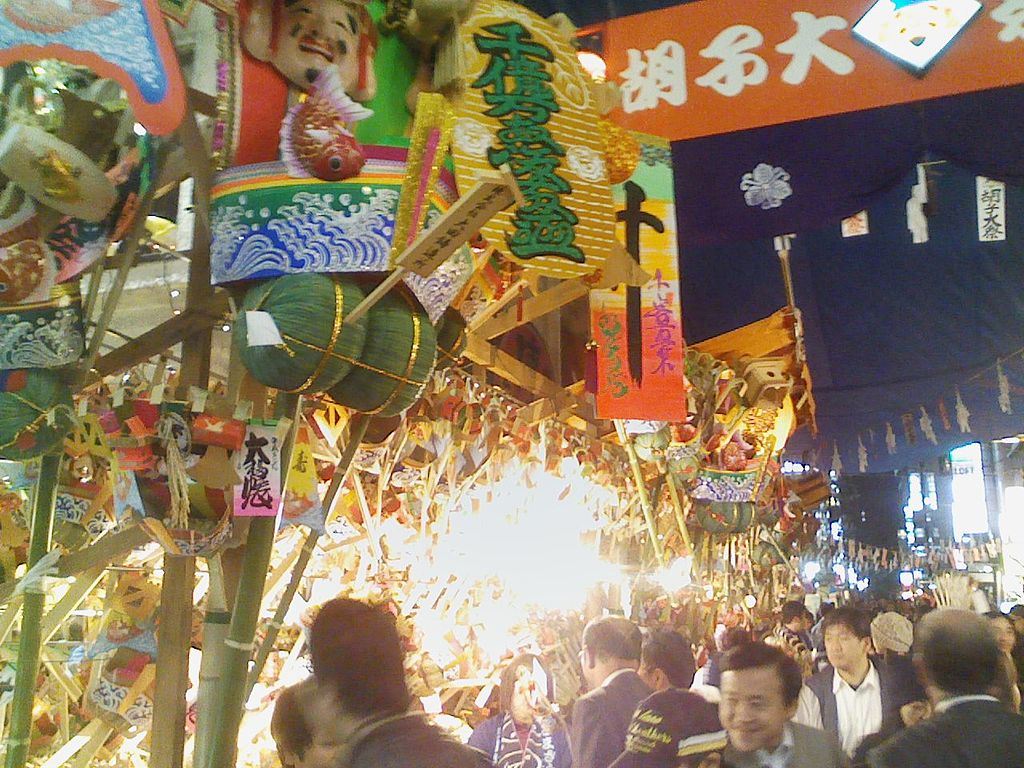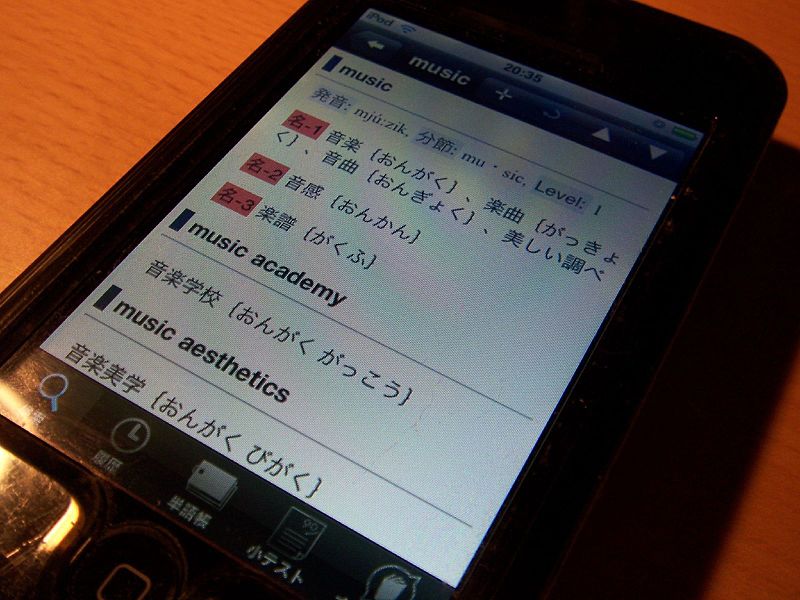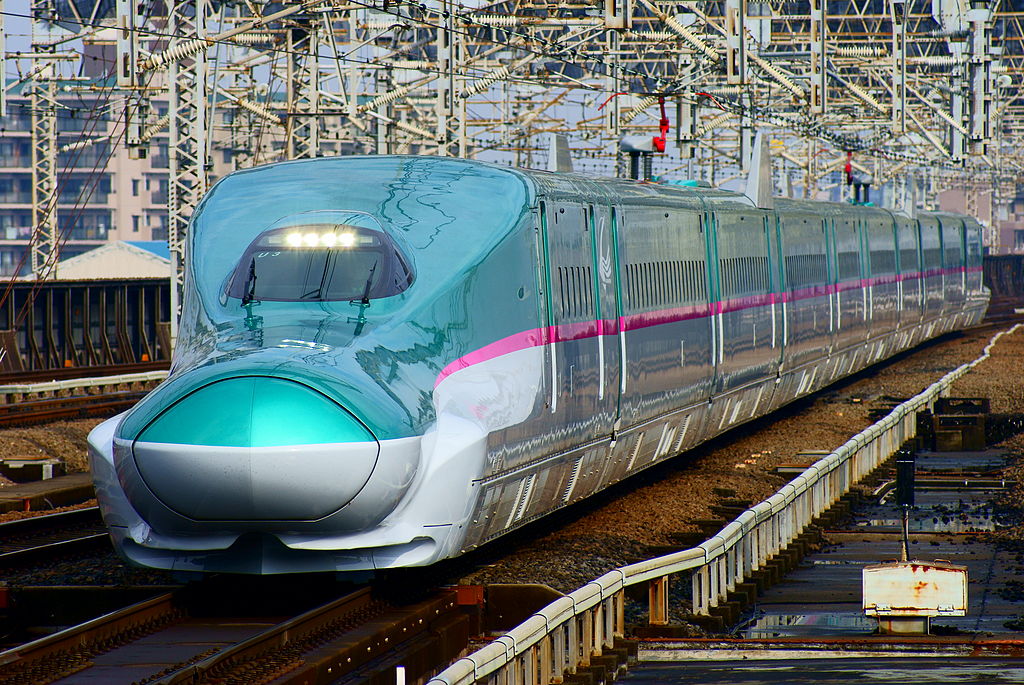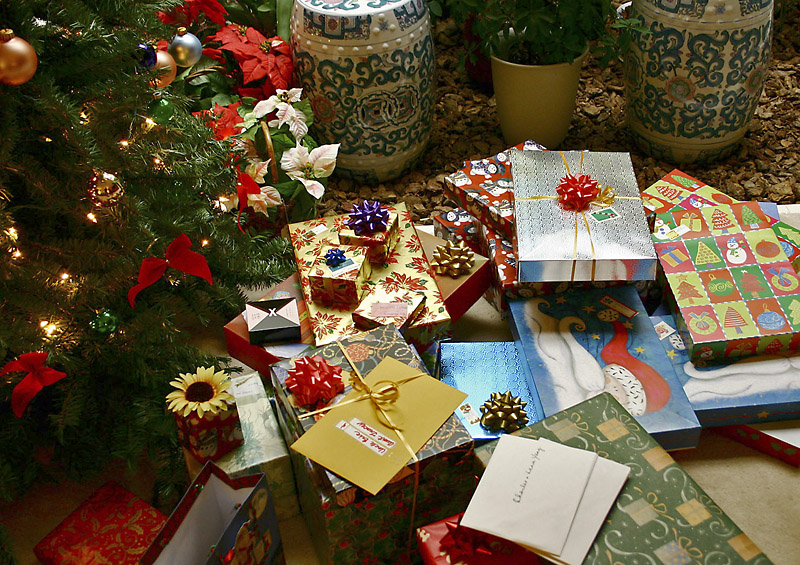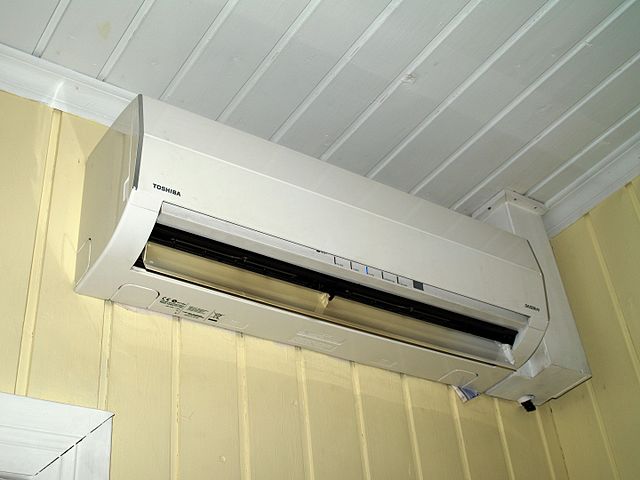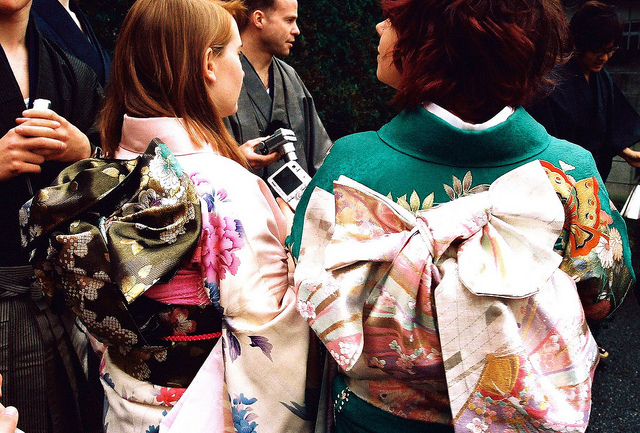Oct 30, 2018
Fall Festivals in Tokyo
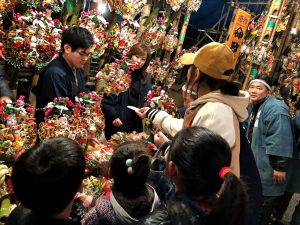
Just because the leaves are golden (or gone), and the temperature has fallen, doesn’t mean the festival numbers have gone down along with it. As always, you’ll be able to eat tasty yatai street food, purchase cool trinkets, and enjoy being outside in the crowd… Just remember to bring your jacket!
Fall in Japan means it’s time for “Tori-No-Ichi” festivals; literally, “market held on the day of the rooster” (the old Chinese calendar noted the day of the rooster comes every 12 days in November). Here, all sorts of things are sold to get ready for the busy time at the end of the year and bring luck for the coming year, including kumade rakes, which are blessed charms businesses buy to “rake in cash” by hanging them in their establishments. Some of these ornately decorative charms are over US$1000, but many are priced within reason if you fancy picking one up.
Hanazono Shrine Tori no Ichi
31 Oct-1 Nov, 12-13 Nov, 25-26 Nov 2018
If you have business in the Shinjuku area over the next month, you can’t go wrong visiting Hanazono Shrine; wedged literally in the middle of the ward’s government complex. This Tori no Ichi festival is over 400 years old, and even though the neighboring Golden Gai and Kabukicho area are as modern as ever, there’s no sign of this old-school fall festival falling out of style.
Address: 5-17-3 Shinjuku, Shinjuku-ku, Tokyo
Access: Shinjuku San-chome station [M09][F13][S02]; Shinjuku Station [JB10][JC05][JA11][JY17][JS20][OH01][KO01]
Web: http://www.hanazono-jinja.or.jp (Japanese)
Asakusa Tori-no-ichi
1, 13, 25 Nov 2018
Admittedly not exactly a hop and a skip away from the main action that happens around Senzō-ji to the south, the festival at Ōtori Jinja is still worth the extra walk because of the “shitamachi” factor. Shitamachi is one of Tokyo’s oldest neighborhoods, and you’ll be mingling with
Address: Ōtori Shrine, 3-18-7 Senzoku, Taitō-Ku, Tōkyō-to
Access: Iriya Station [H18]
Web: www.torinoichi.jp/
Okunitama Tori-no-Ichi
1, 13, 25 Nov 2018

The other major place to catch this same festival is in the city of Fuchū, in Tokyo’s western suburbs. There are many stalls in place here, and it is also customary to get a “financial fortune” read if you are a business owner or have a venture you wish to embark on in the coming year. For practical purposes, Okunitama is also only a short 5-minute walk from Fuchu station, and there’s a huge mall complex in between, so you can make a good day of it if you plan right.
Address 3-1 Miya-machi, Fuchu-shi, Tokyo
Access Fuchū Station [KO24]
Web: www.ookunitamajinja.or.jp/
Smart Illumination Yokohama 2018
31 Oct-31 Dec 2018
Japan’s Second City gets lit with the latest in LED tech, turning the bay shore next to “Elephant Trunk Park” into a digital nighttime art installation. The main festival happens from Oct 31 until Nov 4, but the lights will be on until the end of the year, helping out with winter holiday illumination duty.
Address: Zō no Hana Park, 1-1-1 Kaigandori, Naka-Ku, Yokohama, Kanagawa
Access: Nihon-Odori Station [MM05]
Web: www.smart-illumination.jp
UNU Flea Market: Fall Sake Fest
17, 18 Nov 2018
Remember the coffee festival we reported on in the springtime on the grounds of the UN University’s flea market? This is the same thing, just with sake making the rounds. More than 30 makers of Japan’s signature adult beverage will have their wares out for tasting, so make sure you “pregame” accordingly!
Address: UN University, 5-53-70 Jingumae, Shibuya, Tokyo
Access: Omotesando Station [C04][G02][Z02]
Web: www.farmersmarkets.jp/
Shichi-Go-San Festival
around Nov 15
You’ll likely notice a lot of well-dressed parents toting along with their three, five, and seven-year-old children clad in their best kimono around this time. They are heading to area shrines to pray for the children’s future health and good fortune, and also take family photos that will become keepsakes for their generation. Not necessarily a festival exactly, but some local shrines have set up a food and games stall or three to entertain the families waiting; you can simply hang out, and people watch for a spell if inclined.
Shichi-go-san festival information
Also, let’s not forget about fall leaf viewing and winter illumination festivals that are popping up around town during this time as well!
— By Jason L. Gatewood
Images: Okunitama Tora-no-Ichi by Jason L Gatewood
Oct 29, 2018
Hiroshima’s Ebisuko Festival 2018

Across Japan, Ebisu is one of Shinto’s most popular deities. Deaf and lame, and always laughing (hence the Japanese term ‘ebisugao’ for a smiling face) Ebisu is the god of fishermen and good fortune. The old tenth lunar month was called ‘kannazuki,’ or the month without gods because the entire Shinto pantheon was said to hold an assembly at the grand shrine in Izumo. But Ebisu, deaf as a post, never heard the summons, and as a result was the only shrine god available for petition during this time. And that brings us to the Ebisuko Festival.
In Hiroshima, city merchants have long regarded Ebisu as a critical member of the sales team, and since 1603 the annual Ebisuko Shrine festival has been one of the city’s most beloved events. It’s never been skipped once in all those years. Even in 1945, a scant three months after the atomic bombing of the city, survivors gathered to observe the festival. You can find haunting old footage of a 1937 festival here, with images of area shop owners announcing sales and conducting a roaring festival trade. Locals are apt to call the festival “Ebessan,” indicating their easy familiarity with both the god and his big yearly party.
The shrine itself was once larger, but for many years now has survived as small structure tucked into Ebisu-dori, the easternmost section of the downtown shopping arcade. Presently, it stands between Labi, an electronics store, and the rear entrance to Mitsukoshi department store. For a casual visitor it can be easy to miss, but if you sit, say, on the second floor of the venerable Mont Blanc cafe just across the street and watch a while, you’ll see a regular trickle of local business owners walking up the steps to rattle the ‘suzu’ bell and pay their respects.
It all changes from November 18-20, right in the middle of that month without gods, when as many as 300,000 people visit the tiny shrine and the area adjacent to celebrate. The atmosphere can be raucous. The festival is right on the edge of Hiroshima’s sprawling entertainment district, and there’s a lot of passing back and forth between the two. In former years, local ‘bosozoku’ gangs of young bikers were a persistent and profoundly obnoxious presence, and though the police cracked down on them sharply following an especially bad year in 1999, there’s still a youthful, slightly crude air to the proceedings that only makes it all more appealing. On one of the nights (usually the first) the adjacent portion of Chuo-dori is closed to car traffic and stages are erected for dance, drums and kagura performances.
In front of the shrine itself, you’ll find a large wooden barrel that slowly fills with cash over the course of the festival, as people lob coins, thousand yen bills and even the odd ten thousand yen in to offer thanks and ask for continued fortune in the coming year. Since 1901, the festival has also been known for selling ‘komazarae.’ These are bamboo rakes, in all different sizes, decorated with gold coins, treasure ships and other talismans meant to attract money. Some even say the rake form itself is intended to “rake in” the cash. Wherever you go in Hiroshima, you’ll spot these hung over the doors and behind the counters of restaurants and izakaya all over town.
So, in brief, one of the city’s three big festivals, and an unchallenged fixture of its history for over 400 years. Come check it out, and go home with a great big ebisugao.
Additional Information
Location: Ebisu-dori, behind the large Labi Electronics and Mitsukoshi Department Store.
Time: November 18-20, all day.
Access: There’s lots of paid parking within walking distance, but you’ll find it most accessible to take any downtown-bound public transportation and get off at Hatchobori. From there, walk south to Ebisu-dori.
Admission: Free
Telephone: +81-(0)82-241-6268
noppo3 [CC BY-SA 3.0 ], via Wikimedia Commons
Oct 29, 2018
Firewalking at Miyajima 2018

Japan has a slew of fire rituals, the most famous of which being Kyoto’s famous Daimonji Festival. These festivals, leveraging ancient notions of purification and renewal, continue to draw people even in the modern world. In Hiroshima, November offers two chances for visitors to experience ‘Hiwatari,’ or firewalking. The first is at Daiganji and the second at Daishoin, two old Shingon temples on Miyajima. Let’s take Daiganji first.
Daiganji Fudo Myo-o Festival
Daiganji is located just beyond the western exit from Itsukushima Shrine, which is where you’ll come out if you’ve bought your ticket and walked through. Daiganji’s age is uncertain, but it may be nearly as old as the Shrine itself, and under the old ‘bettoji’ system linking temples and shrines, Daiganji was in charge of carpentry and physical maintenance for Itsukushima. It is also one of Japan’s three most famous temples dedicated to the figure of Benzaiten, goddess of music, wisdom, and eloquence. Her image is open to viewing by the public once a year, on June 17. There are three other Buddhas enshrined here as well, along with a well-worn ‘nadebotoke,’ a wooden image of the arhat Binzuru that the faithful rub in places corresponding to their physical ailments.
In 2006 Daiganji’s Gomodo Hall was rebuilt for the first time in nearly a century and a half to house a new, four-meter tall sandalwood statue of Fudo Myo-o, the fierce Wisdom King who represents (among other things) steadfastness and the destruction of doubt and evil. Each year a festival is held in his honor. In 2018, it will take place on Saturday, November 3. The ritual begins with sutra reading and a goma burning ritual at 13:00. At 14:00, the firewalking begins, led by the priests of the temple. Visitors are welcome to participate but note that you will be required to remove your shoes and walk barefoot. Fortunately (or not), by the time you begin walking the coals will most likely have been trodden to a thin layer of barely warm ash. Still, the ritual is unusual, and afterward, you are welcome to a reception area for celebratory tea and cakes.
Daishoin Hiwatari Shiki
I’ve written about Daishoin here before. The head temple of Shingon’s Omuro sect is located farther up the slopes of Mt. Misen from Itsukushima, and is a fantastic place to explore even when nothing unusual is happening. But twice a year, you can line up with hundreds of other visitors, ranging from the devout faithful to tourists who’ve accidentally wandered in at the right time, to tread a path through burning coals. The ceremony takes place on April 15 and November 15, regardless of the day of the week. In 2018, November 15 is a Thursday, which means that if you can make it you’ll avoid the worst of the weekend crowds.
Daishoin’s firewalk ritual is linked closely to Shugendo, the syncretic mountain religion of the famous ‘yamabushi.’ The ceremony commences at 11:00, with sutra reading and offerings before the main Honden hall. Next, priests launch seven arrows into the sky, which more foolhardy believers will scramble to catch as they fall to earth. Yamabushi blow their conch horns, and the cypress bonfire is set ablaze. After it has burned down, the coals are raked out, and the firewalking begins. As at Daiganji, you’ll need to remove your shoes and, unless you manage to make it to the front of the line, the walk won’t be especially blistering. The ritual is guaranteed by believers to confer both health and luck on those who take part, so loosen your shoelaces and don’t be late.
Additional Information
Location: Daiganji and Daishoin Temples, both on Miyajima
Time: Daiganji: Saturday, November 3, 13:00 to about 15:00. Firewalking begins at 14:00.
Daishoin: Thursday, November 15, the ritual begins at 11:00.
Access: JR Ferry from Miyajimaguchi, 360 JPY round trip for adults, 180 JPY for children. From the Miyajima ferry terminal, Daiganji is a fifteen-minute walk, Daishoin about 25 minutes. English language maps of the island are available free in the ferry terminal.
Admission: Free
Website: Miyajima’s official English website is here, and is very good: http://visit-miyajima-japan.com/en/
fir0002 | flagstaffotos.com.au [GFDL 1.2], from Wikimedia Commons
Oct 29, 2018
Hiroshima Grand Inoko Festival
Inoko Festivals are a familiar feature of autumn across western Japan. Hiroshima has been running its own Grand Inoko festival since 1990, although there was a 17-year hiatus prior to 2013. This means the 2023 festival marks the 10th anniversary and so should be extra special.
What Are Inoko Festivals?
With roots in ancient Chinese harvest festivals celebrated in the tenth lunar month (the month of the boar), Inoko celebrations were observed in Japan as early as the Heian period. Over time, they developed into several distinct expressions — from the festival of the court down to that of the common folk. It’s this latter version that still leads crowds of children in red or blue ‘happi’ through the streets of their neighborhoods each autumn. Following the sound of drums, they carry a stone or heavy wooden weight supported by ropes. At each crossroads, the children pause to raise and drop the stone repeatedly, hammering the ground rhythmically as they chant ‘Inoko, Inoko, Inoko Mochi Tsuite, Hanjose, Hanjose!’ This means, roughly, “Month of the boar, month of the boar, make rice cakes and prosper, prosper!” At the end of the procession, the adults in charge pass out snacks and the children go home tired and happy.
The festival has ritual elements associated with harvest, continued fertility, and protection from fire. But if you ask the children what it all means, they’re no more likely to have an answer than a child elsewhere might start to pick apart the strands of Celtic lore and medieval superstition lurking behind Halloween. The point, from the children’s perspective, is the noise and the fun and the bag of treats. And that noise and fun, as well as a wish to revive the spirit of childhood on a grand scale, is the impetus for Hiroshima’s Grand Inoko Festival.
About the Grand Inoko Festival
In place of the tired grandfather wheeling a drum up and down the street, the music at the festival in Hiroshima includes both traditional koto and flute as well as drums and more avant-garde performances. The festivities also last longer and there’s generally a lot more sake around. But, most importantly, the stone at the heart of inoko has been reborn as a one-and-a-half-ton rock suspended by ropes from 88 bamboo poles, each 13 meters tall and arranged in a circle at the center of Fukuromachi Park — a short walk south of the Hondori shopping arcade. When the chanting begins and that boulder starts leaping up and down as the bamboo thrashes overhead, the child in you will be completely thrilled.
What to Expect
On Saturday, November 4, a children’s Inoko parade will kick things off from 11:00 a.m., moving through Hondori and Kinzagai. At 3:00 p.m., kids and parents are invited to lend a hand at the first raising and dropping of the stone. They can even pose for pictures atop the thing — that’s my own daughter at the top of this article. Children also have the chance to try their hand at making traditional bamboo toys like dragonflies and flutes or roasting marshmallows on bamboo skewers.
Adults will get funny looks if they ask for a marshmallow. Don’t worry. If you’re hungry, you’ll find plenty to satisfy you at the festival’s food stalls. They sell udon, wild boar, okonomiyaki, a “specialty grill,” and the aforementioned sake, served (naturally enough) in bamboo cups. The food stalls open around the same time the parade begins.
To finish the celebrations on Saturday, there will be a ritual dedication called Omote-Syukusai, which starts at 6:30 p.m. This is a fusion of music, dance, art, and more. In previous years, this has finished at 8:10 p.m.
The festivities will continue on Sunday with more events. There will be a second raising of the great stone at 1:00 p.m. — this one for the locals rather than for kids and their families. This is followed by another parade (this time with a drum performance) from Hondori to Fukuromachi Park at 5:40 p.m.
Things wrap up on Sunday evening. At 6:00 p.m., there will be another ritual dedication, called Ura-Syukasai. Attendees then receive traditional mochi cakes before the Tsunakiri (the grand finale), which features the ceremonial cutting of the ropes at 7:30 p.m.
Whatever time you drop by, you’ll find something to do, eat, listen to, or watch. It’s worth rolling it into a day downtown and wandering to and from the festival over the course of a long afternoon and evening. You’ll find the festival is great fun and offers a real sense of community in the middle of the city.
Put it on your calendar!
Additional Information
Location: Fukuromachi Park, three blocks south of Hondori and one block west of Namikidori.
Time: Saturday, November 4 and Sunday, November 5 from 11:00 a.m. to about 8:10 p.m.
Access: Nearby parking is all paid. Since the park is in the heart of downtown, public transportation to Hondori is far and away the easiest option.
Admission: The food stalls charge. Otherwise, this event is free.
Telephone: +81-(0)82-545-7611
Website: (Japanese) www.cetra.jp/ooinoko/index.html (English, limited information) www.cetra.jp/ooinoko/en_index.html
Photo by author
Oct 29, 2018
Apps for Learning and Using Japanese

Living in Japan means having to some extent assimilating to one of the most complex language systems mankind has devised, or at least that’s how it feels. The spoken language is a mixture of original Japanese words mixed with ancient and modern Chinese, English, Spanish, and Portuguese loanwords that are used every day, sometimes in the same sentence. The writing system is a mix of Chinese ideograms, two collections of kana, characters used to represent the basic phonetic alphabet, and thanks to a long history of international trade, roman letters, and Arabic numerals. It takes the average Japanese child 8 years of schooling to get to the point where they can read a full newspaper.
Are you ready for the challenge? We won’t focus on trying to get to NHK newscaster levels of fluency fast here; it’s more important to be able to communicate things like “where is the nearest grocery store” and “I’ve fallen and I can’t get up!”
Prep Time
I wish there were smartphones and apps when I started down the road to learning Nihongo. The number of books and dictionaries I amassed back in the day is why I have no problem lugging heavy luggage on the Yamanote Line these days. Thankfully, now all you’ll need is your trusty pocket communication device (smartphone) and in most (but not all) cases, an internet connection. Before we get to the learning apps, we’d better make sure we have our device set up with the proper base apps for not only learning but daily life in Japan.
Google Translate
You’re likely already using this app anyway, but perhaps not aware of the various functions it can do aside from typed translations. There’s the handwriting function, very useful if you need to scrawl in some Japanese kanji and don’t know how to type it in kana. You can also use the camera function to take a picture of some text and it will change it on the fly into the language of you choice.
Google Translate on the App Store
Google Translate on Google Play
Imiwa/JED
You’re gonna need a good English-Japanese dictionary to refer to whenever you get stuck trying to find the meaning to a word and all its uses, synonyms, and written forms. Both of these come at the low low price of free, and are based on the open-source JDICT project so as words get added to the lexicon, their databases are updated accordingly.
JED Japanese Dictionary on Google Play
Yomiwa Japanese Dictionary on the App Store
Google Keyboard
You’ll need to type in Japanese on your device too. Sure you could use the default keyboard app and perhaps switch it to Japanese, but it won’t have Google’s updated dictionaries but built-in searchability.
Google Keyboard on the App Store
Google Keyboard on Google Play
App-ified Learning

Now with that out the way, we can get down to the business of learning and understanding. The easiest way to learn anything is to break it up into small chunks, then make a daily routine out of ingesting and using the new vocabulary in real situations. Here are a few apps I’ve used on both platforms to both learn and keep my skills sharpened.
Memrise Context
Memrise Context is always key when it comes to languages. Using the power of prerecorded video of common interactions so you can see Japanese in action, this app will have you remembering those “daily life phrases” in no time. I also liked using the drills in the app due to the gamification add-ons.
White Rabbit Press
This company has been making materials for Japanese study for a long time. If you’ve studied Japanese in a formal class, chances are you have touched a flashcard pack, reader, or audio CD from them. Their app combines all their expertise into an all-in-one method to help your reading and listening skills improve.
Japanese Graded Readers for iOS and Android by White Rabbit Press
Learning Japanese with Tae Kim
Sometimes you just need to know exactly when a certain grammar rule is used or what verb ending should be used to denote a certain context. This app will explain that not from an English but from a Japanese point of view. I found that by just treating the language as a blank slate with a completely different set of rules and throwing out any relation to English grammar, was I able to simply start using Japanese practically right away.
Tae Kim’s Guide to Learning Japanese in the App Store
Tae Kim’s Guide to Learning Japanese on Google Play
Let the games begin
Nothing beats rote practice. Back in the ancient times of the late 1990’s I could usually be found scanning index cards and small flash cards on a keyring to help reinforce my kanji and bunpo understanding. But that’s all dinosaur fodder now; we can practice and save the galaxy at the same time on our smartphones because they’ve gameified practice and quiz sessions!
Japanese Dungeon: Learn J-Word on Google Play
Learn Japanese by MindSnacks on the App Store
Kanji Quest – study for JLPT in a fun Kanji Game ! – Apps on Google Play
Kanji Mnemonics: Learn Japanese fast with Dr. Moku on the App Store
More to come…
There’s more out there in terms of apps and websites to help you get started on your journey into the world of Nihongo. Please feel free to add to this list by letting us know in the comments section!
— By Jason L. Gatewood
Images:
Oct 26, 2018
Get the Seishun 18 Kippu and See Japan on the Cheap!

If there is one thing that Japan does well it is train travel. While the locals take it for granted that trains will be clean, safe and punctual, many of us know that this is not necessarily the norm in other nations. Another fantastic aspect of Japanese travel is the fact that, at certain times of the year, for a mere JPY 2370 a day you can travel as much as you want, for as long as you want, wherever you want.
What is the Seishun 18 Kippu?
The Seishun 18 Kippu is a ‘norihodai‘ (travel as much as you like) pass that allows the carrier unlimited JR travel throughout the country for five full days. Unlike the JR Japan Rail pass which is limited to travelers possessing a tourist visa, this pass can be used by absolutely anyone, whether they are residents or just passing through.
First created in 1982 to encourage students to travel during extended holiday periods, despite the inferences of the ticket’s name (it is literally translated as Youth 18 Ticket), there are no age restrictions, so whether you are an elementary school student off to visit grandma for New Year, or a retiree wanting to explore areas of the country you are yet to see, for JPY 11,850 you can travel all over the country for five whole days (midnight to midnight).
Another way in which the Seishun 18 Kippu differs from the JR Rail Pass is that it can be shared among a group and used on non-consecutive days. In this way, you can travel somewhere and hang around for a few days before heading off without losing travel time. If you are in a group of five, you can share it for one day’s travel, or any combination in between.
Where and when can I use it?
The Seishun 18 Kippu can be used on any JR local (futsū) and rapid (kaisoku) trains, but not the faster Express, Limited Express or Shinkansen bullet trains. While this means that it may not be the ideal way of getting to an important meeting on the other side of the country, it is perfect for relaxing travel and, from Hokkaido to Kyushu, you can watch Japan’s bountiful nature slip past you. Other than the faster express and bullet trains, you are completely unfettered in your JR travel options, even including the JR ferry to Miyajima, home of the famed Itsukushima shrine. The only additional limit you may find is there are only 24 hours within one day, though this can be minimized by taking “Moonlight” overnight trains. While many of these are classified as express an unavailable, some are not and these must be reserved at additional cost.
Where can I get it and how do I use it??
The Seishun 18 Kippu is sold three times in a year, in the winter, spring, and summer and are valid for approximately one month only (see chart below) . They can be purchased over the counter at all JR stations. When entering a platform via a manned turnstile, show your ticket to the officer who will stamp your ticket. The tickets cannot be used in the automated turnstiles. For help with planning your trip, you can call the JR East Infoline (03 0423 0111) and speak to an English speaking customer service assistant who should be able to answer any of your questions.
Spring Seishun 18 Kippu
Valid – March 1 to April 10
On Sale – February 20 to March 31
Summer Seishun 18 Kippu
Valid – July 20 to September 10
On Sale – July 1 to August 31
Winter Seishun 18 Kippu
Valid – December 10 to January 10
On Sale – December 1 to December 31
So, if you have some extra time over this winter vacation and want to see the country at a leisurely pace, meet interesting people and do so in a cost-efficient way, why not grab that book you have been meaning to tackle, charge up that sense of adventure, and get out and see parts of this beautiful country away from the oft-beaten shinkansen track. This winter, slow is the new fast.
By Mark Guthrie
By Nanashinodensyaku (Own work) [CC BY-SA 4.0], via Wikimedia Commons
Oct 25, 2018
Mailing Christmas Gifts Home from Japan

The first of November in Japan is marked by a noticeable drop in temperature and the sudden appearance of decorations and music in public spaces with Christmas themes. In our home countries, this early appearance would annoy us a bit, but this is Japan, and at least it reminds us that this is the perfect time to begin Christmas shopping if planning to shop locally and send gifts home via air mail.
The most commonly used (and user-friendly!) service is EMS (Express Mail Service) from Japan Post. Because this is a tie-up with other post offices internationally, it is usually both economical and fast. Prices start at just JPY 900 for a 300-gram package. Because the service is through Japan Post, you can EMS at any post office location. And remember, most significant offices in Tokyo are staffed with English-speaking staff. The website is also in English as well and allows you to print labels, calculate rates, estimate delivery time, and so on. You can also find the phone number of your nearest post office and schedule a free pickup of your package if it is already ready to be mailed.
Next are the private services. You’ll pay a little more, but you’ll get a little more in the way of convenience as well. All offer home or office pick-up and have English websites. However, if you don’t feel like waiting for a delivery driver, you can pop into almost any convenience store; most are officially supported by Yamato Takyubin or Sagawa. There, you’re able to fill out forms and pay for shipping with cash or (in some cases) a credit card.
 If you want to give something from Japan but not deal with shipping headaches, you can try shopping online from Rakuten or Amazon Japan. These sites stock a lot of “only in Japan” goods like tea sets, housewares, and even traditional souvenirs. When you get to the shipping section on the site, you can opt for the goods to be drop-shipped to a different address internationally. If you will be simply sending your loved one or friend a gift and “Japaneseness” isn’t a priority, then just use the website of your choice in whatever country that person resides in; this is how I’ve been “sending Xmas cheer” for the last few years. There’s no hassle, no wrapping, no worrying about dates and customs forms this way either.
If you want to give something from Japan but not deal with shipping headaches, you can try shopping online from Rakuten or Amazon Japan. These sites stock a lot of “only in Japan” goods like tea sets, housewares, and even traditional souvenirs. When you get to the shipping section on the site, you can opt for the goods to be drop-shipped to a different address internationally. If you will be simply sending your loved one or friend a gift and “Japaneseness” isn’t a priority, then just use the website of your choice in whatever country that person resides in; this is how I’ve been “sending Xmas cheer” for the last few years. There’s no hassle, no wrapping, no worrying about dates and customs forms this way either.
Back in the good-old-days, giving a gift card could have marked you as being “that guy that gives uncreative presents,” but now that we live in the age of Netflix and Nintendo Online, most people don’t mind getting them in the slightest. I tend to use Gyft, a service, and app that lets one purchase and send out electronic gift cards. It’s a bit easier than the regular method of going to each store’s website and doing it manually since they’re all in one place. Just remember this is an American service, so the resulting cards will only work in the US.
Lastly, whichever way you choose to send your holiday cheer, remember to do it as early as possible to avoid any delays due to customs and delivery on the receiving end. Happy holidays and happy shopping!
— By Jason L. Gatewood
Photo by Kelvin Kay, en:user:kkmd [GFDL or CC-BY-SA-3.0], via Wikimedia Commons
Photo by Ray Proper
Oct 25, 2018
Conserving Electricity: Lower your Electric Bill in Japan!
You may not have known it, but you may come from a country with comparably cheap power. Japan is a great place, and we got lots of “stuff” to be proud of here, but cheap power isn’t one of them. Leaving your AC or heater running to keep your cat comfortable while you are at work may have been perfectly reasonable at home, but here the bill at the end of the month might surprise you… unpleasantly.
To avoid any such unpleasantness we recommend you look through this list of common appliances and how much it costs to run them. A little bit of knowledge might save you a whole bunch of cash.
Electricity Usage of Selected Appliances
Key: Appliance (factors) unit price ~ annual cost.
* “Jo” is a measure of room size. More info on room sizes here.
- Air-conditioning Unit (*6~18 jo room) JPY 16,000 ~ 50,000/unit
- Washer and Dryer (10kg, everyday use) JPY 9,500 ~ 23,000
- Dish Washer (11 liters. twice a day) JPY 15,000
- Refrigerator (168~601 liters.) JPY 8,400 ~ 10,000
- Light Fixture (*12 jo room, 8hours/day) JPY 3,200/one light fixture
- TV (24~50 inch) JPY 829 ~ 1,554
- Iron (10 min./day) JPY 2,300
- Rice Cooker (5.5 rice cups ) JPY 2,200
- Hair Dryer (10 minutes/day) JPY 2,000/one person
- Microwave JPY 1,600
- Vacuum Cleaner (10 min./day) MAX: JPY 1,400
Save Money When Using Air-conditioning
- Use a fan or a circulator at the same time as the AC unit. Make sure you turn the fan/circulator upward.
- In Japan, the “proper temperature” to set an AC is 28℃ (82.4f) in summer and 20℃ (68f) in winter. (Seriously!)
- Clean the filter every 2 weeks. http://japaninfoswap.com/how-to-clean-your-air-conditioner
- Use the automatic operation mode, so the AC only kicks in when needed.
- Do not put or store things around the part of the AC that sits outside.
- Do not turn the AC on and off for only a short time (ex.30 min.), because the most electric power is consumed when it starts.
- Keep the vane (fan blades) pointed down while warming room, keep the vane flat while cooling one.
- In summer, close the curtains or the blinds to shut the sunshine. In winter, open the curtains to get the sunshine.
Electricity Usage of Heating Appliances
 It is not just hot in Japan, its cold. In some cases VERY cold. In most cases, you are still better off using your AC to heat in winter, but it will depend on your specific circumstances. Below is a list of scenarios and a suggested heating method.
It is not just hot in Japan, its cold. In some cases VERY cold. In most cases, you are still better off using your AC to heat in winter, but it will depend on your specific circumstances. Below is a list of scenarios and a suggested heating method.
Halogen Heater (For *3 jo tatami room) (see examples)
high: JPY 27/hour
medium: JPY 18.09/hour
low: JPY 8.91/hour
Carbon Heater (see examples)
high: JPY 24.3/hour
low: JPY 12.15/hour
Oil Heater (For 8-10 tatami room) (see examples)
high: JPY 32.4/hour
medium: JPY 18.9/hour
low: JPY 13.5/hour
Air-conditioning unit (For 8-10 tatami room) (see examples)
JPY 2.8 ~ 53.5/hour
Hot Carpet (For 2 tatami room) (see examples)
high: JPY 8.5/hour
medium: JPY 6.2/hour
Kotatsu (see examples)
high: JPY 4.6/hour
low: JPY 2.2/hour
The Most Efficient Use of Different Heating Appliances
- To warm the entirety of a large space -> Use an air-conditioning unit
- To warm the entirety of a small to medium space -> Use an oil heater
- To warm a specific part of a space -> Use an oil heater
- To use for only a short period -> Use a Halogen Heater / Carbon Heater
- To warm only your feet or hands -> Use a kotatsu
- To keep the cost as low as possible -> Use a kotatsu
Photo by: www.fepc.or.jp Used without permission http://www.fepc.or.jp/english/about_us/service_areas/
Photo by: Santeri Viinamäki [CC BY 4.0], from Wikimedia Commons
Oct 24, 2018
Castles in and Around Nagoya

Inuyama Castle
Nagoya Castle
Perhaps the obvious place to start, the construction of Nagoya-jo as a replacement to the Yanagi-no-maru castle began with orders from the Shogun Tokugawa Ieyasu in 1610. Its location along the Tokaido road was of such high importance to both protect trade and resist any potential attacks rising from Osaka, that rumor has it the castle’s chief architect Nakai Masakiyo was killed to ensure he would not relinquish the castle’s security secrets.
Unfortunately, the building, along with the famous Kinshachi, or golden dolphins (ironically intended as a talisman to prevent fires), was razed to the ground by an American air raid on May 14, 1945, but it was reconstructed in concrete in the late 1950s. Now, for only ¥500, you can join the 10,000 daily visitors to the castle and wander the grounds, inspect the museum housed within the reconstructed building or overlook the cityscape from a viewing deck.
Inuyama Castle
As well as being one of only 12 Japanese castles remaining from the Edo period, Inuyama-jo also holds the distinction of being one of the four castles designated as national treasures, and it is claimed that, with its construction in 1440, it is the oldest castle in the country.
The castle, which had at one time been under the rule of Oda Nobuyasu (the uncle of Nobunaga) sits overlooking the Kiso River and as such is a popular destination for the viewing of cherry blossom in spring and the changing of the leaves in autumn. The building itself is made of wood, and the internal plans give the authentic layout of an old Japanese castle, right down to the steep, polished wooden stairs, which can be a little treacherous in your bare feet. Tours in English can be provided by volunteers upon request.
Website (Japanese)
Kiyosu Castle
The birthplace of the samurai leader Oda Nobunaga, and the location of a meeting held by Toyotomi Hideyoshi that ultimately lead to the Battle of Sekigahara, Kiyosu-jo was demolished by Tokugawa with its parts contributing to the construction of Nagoya Castle. That the current structure was built in 1989 should not take away from the beauty of the four-storied building, and the gorgeous red bridge that leads up to it.
Admission is a mere ¥300, and inside there is a museum of local artifacts, displays of armor and you can dress in the traditional samurai clothes of the region.
Website (Japanese)
Okazaki Castle
Okazaki castle, listed as one of Japan’s Top 100 Castles in 2006, is also steeped in history. Built sometime around 1531 it is famed for being the birthplace of Tokugawa Ieyasu. Along with many other castles in the region, it was demolished under instructions of the Meiji government in 1873, and the current structure was rebuilt in accordance with the original model, but from concrete, in 1959.
Okazaki-jo sits alongside the Otogawa river, and is a favorite hanami spot, as the area is lined with cherry blossom trees, and many food stalls spring up at this time. Inside the castle itself is a museum with many audio and visual aids to help recreate the feel for the area as it once was. For a combined price of ¥500 visitors can enter the castle as well as the museum dedicated to Tokugawa Ieyasu and the famed Mikawa Bushi samurai fighters.
By Mark Guthrie
Photo: wikipedia Imuyama Castle (CC BY-SA 3.0) -Modified
Oct 22, 2018
Christmas Present Ideas From Japan

Whether you love it or loathe it, Christmas shopping time is pretty much here. Personally, I’m in the latter camp. As the eldest of 13 cousins (and now countless cousins-once-removed) Christmas shopping becomes a Herculean task, as coming up with ideas for presents becomes increasingly difficult.
Thankfully, being here in Japan we have a wide range of fresh, different and (on occasion) crazy things that we can give to people. What do you get for the person who’s got everything? Something from Japan, because I bet they’ve not got it. Here are a few ideas that may spark your imagination.
Kimono
An obvious choice, but a good one. For Christmases past I have bought kimonos for both my mother and my sister, and it certainly gives that ‘wow’ factor when it comes to opening time on Christmas morning. And perhaps the best thing about giving a kimono as a gift is that it looks pretty expensive, but can often be picked up quite cheaply at second hand stores.

The only issue is that, after the initial amazement of the present, there aren’t many opportunities to wear a kimono back at home. That said, my mother wears hers as a dressing gown around the house after taking up the hem (kimono can be quite long when you aren’t using the obi belt with it), and my sister has taken to regularly getting takeaway sushi from a nearby Japanese restaurant and wearing it when she invites friends round for a few drinks. If you want something more practical, a jinbei makes excellent home wear.
Sake
Rice wine, known as ‘nihonshu’ in Japan or ‘sake‘ around the world, is the perfect gift for that family member you don’t know all that well. I usually get a bottle of the stuff for my brother-in-law and as there is such a wide variety (and it can be pretty cheap) there is a near endless supply of choices. If you want to make it a little bit more personal, why not include a ‘tokkuri’ and ‘ochoko’ bottle and cup set?
Of course, sake can be something of an acquired taste, and not always appreciated (according to an uncle of mine who was less than impressed with his present last year). As such, whiskey makes a great substitute. Japan produces some fantastic whiskeys, with the Yamazaki Single Malt Sherry Cask 2013 being described by Whisky expert Jim Murray as a drink of “near incredible genius,” awarding it 97.5 marks out of 100 in the 2015 World Whisky Bible. This year one of the most popular brands, Hibiki 17, has been almost impossible to get abroad since it was named as the best in the world creating a domestic rush on the single malt. You may have to smuggle this one out of the country…
Little Things
So far, so pricey. But things don’t necessarily have to get too expensive, as Japanese handicrafts and goods can be bought pretty cheaply. Chopsticks are a good start and can be found pretty much anywhere – from supermarkets to 100 Yen stores, to specialist shops. Some places will even engrave names of them, which is a nice touch.

Otherwise ornate-looking fans and small accessories such as purses made from kimono material and wooden ‘geta‘ sandals all make for nice gifts. On more than one occasion I have bought tenugui towels that can be fashioned into handbags and wall hangings, and they generally garner repeat requests. If you are artistic, you could copy an idea that a friend of mine had, which was to have a Japanese speaker work out a family name in Japanese, and wrote it in kanji along with all the names of the family in katakana using a Japanese calligraphy brush and had it framed.
Tasty Treats
Another gift idea that isn’t going to break the bank is Japanese snacks and drinks, and thanks to their (often) unusualness, they will be a strong talking point around the Christmas tree. The most obvious here would be matcha, or green tea. Although it isn’t necessarily to everyone’s taste, it looks great as a gift, particularly if you pair it with a teacup or even a tea-making set.

If you are near a popular tourist spot (or even a largish train station), there will be a number of ‘omiyage‘ gift boxes that you can use as presents – with manju steamed buns, red bean paste cakes or senbei rice crackers all ideal for the purpose. Failing that, the convenience store has a whole load of choices, such as chocolate Pocky sticks, Pretz pretzel sticks, bamboo shaped Takeno no Sato biscuits, green tea-flavored Kit Kat, or even cup ramen. For the more adventurous members of your family, why not try them on some saki ika squid jerky?
For the kids
Something I’ve always struggled with is getting presents for kids, namely as there just aren’t that many toyshops around (though if you are in Nagoya you can find a few here, and for those in of you in Tokyo there are some here).
But if you do find somewhere to shop, or just head over to Amazon/Rakuten, you will find that there are loads and loads of great characters, dolls and figures. At the risk of reinforcing gender stereotypes, some of the most popular toys for girls come from the Purikyua (also known as Glitter Force) range, while a lot of young boys are into Yokai Watch. For smaller kids you can’t go wrong with Doraemon and Anpanman, and last year I bought my three-year-old nephew an electronic Anpanman book (in the video above) with which he can learn both English and Japanese words, and he loves it!
Mark Guthrie
Image: by Kris De Curtis (Flickr) [CC BY 2.0], via Wikimedia Commons
Image: by Kelsea Groves via flickr.com (CC BY-NC-SA 2.0) – Modified
Image: by Yuki Yaginuma via flickr.com (CC BY-NC-SA 2.0) – Modified
Image: by Jack Sem via flickr.com and https://www.semtrio.com/ (CC BY-NC-SA 2.0) – Modified
Image: by sekihan via flickr.com (CC BY-NC-SA 2.0) – Modified
